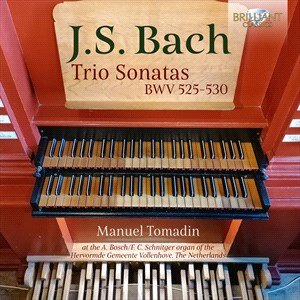

Sonata No.1 in E-flat BWV 525 Sonata No.2 in C minor BWV 526 Sonata No.3 in D minor BWV 527 Sonata No.4 in E minor BWV 528 Sonata No.5 in C BWV 529 Sonata No.6 in G BWV 530
Over the years I've listened to and reviewed many recordings of the Trio Sonatas BWV 525-530 by Johann Sebastian Bach (1685-1750) and they never cease to amaze me. More so than his great Toccatas and Fugues. They may sound simple in comparison, but they are actually more difficult to play in that the three individual parts (they are based on Italian chamber sonatas for 3 instruments), the two keyboards and pedals are constantly involved in the musical discourse. Impressive when you know that Johann Sebastian Bach actually only intended to compose them as organ study works for his eldest son Wilhelm Friedemann, who had already mastered the harpsichord by playing his father's Well-Tempered Clavier, and who now, at the age of 15, had to master the organ so as to be able to partake in the weekly Sunday Cantata performances, by playing the obbligato organ part.
The instrument used for this recording was built in 1686 by A. Bosch. In 1720 major changes were carried out by the great F. C. Schnitger. In 1860 the instrument was expanded to include a free pedal and pedal towers were added left and right of the Main organ by organ builder Jan van Loo. Van Vulpen restored the organ in 1977, based on the situation of 1720. The organ has 25 registers {Booklet Notes}. As you can see, it was built and expanded during Bach's lifetime, and most likely generates the type of sound Bach would have applied himself. Italian organist Manuel Tomadin who is organist in the Luteran Church of Triest, and teaches Organ and Harpsichord at the Triest Conservatory, states that "Bach wrote them during his full maturity and they can be considered the most important compositions of this genre." He makes full use of the organ's limited range of stops to give each Sonata, even at times each individual movement, a diverse sonic character. In some instances, the outer Allegro movements could have benefited from a bit more bounce, but Tomadin's more relaxed tempos allow for clearer contrapuntal transparency.
The audio recording itself sits you at a naturally effective distance from the organ which allows for the building's acoustics to come through, and yet if you listen intently you can discern, at certain points, the organ's mechanical tracker action at play. Any musician with computer skills and a MIDI keyboard at home, can purchase and download the instrument's sampled digital files from the Hauptwerk website, and enjoy playing this pipe organ (virtually of course) from the comfort of your own living room. Recommended to any and all pipe organ enthusiasts.
Jean-Yves Duperron - June 2023 Sonata No. 4 - Third Movement